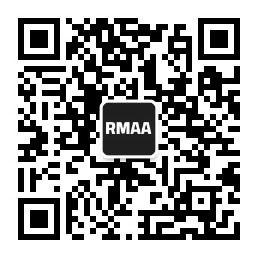Blog about successful marketing strategies in russia
Yandex Marketing: Promoting in the Russian Market via Yandex.Direct


DIGITAL MARKETING
Share this Post
After Google Ads left the Russian market in 2022, brands faced a question: where can they find the right advertising audience on the Russian Internet? Three years later, Yandex.Direct not only filled the gap in paid ads but became the primary tool for promoting goods and services in Russia.
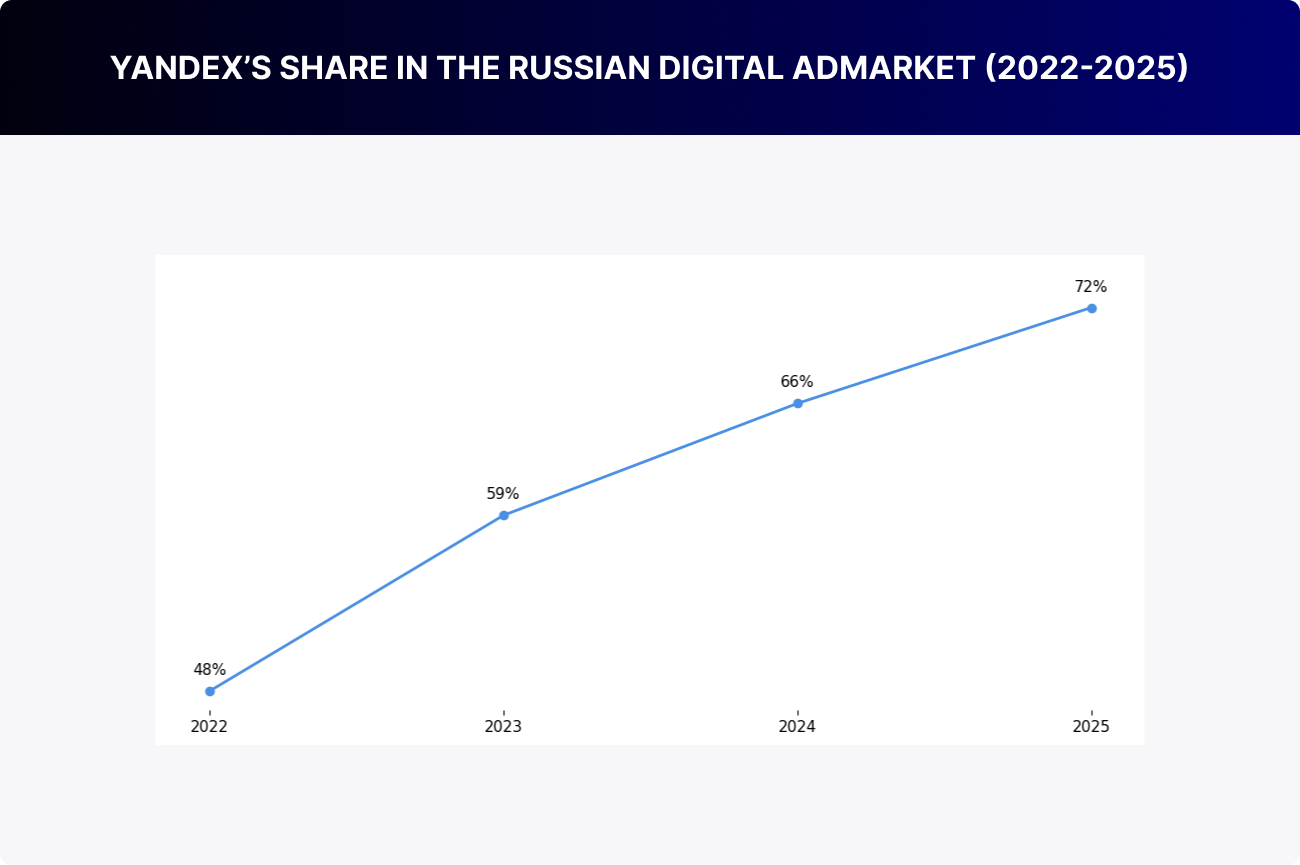
In 2024, it accounted for 74.41% of all clicks. For comparison, Google only had 24.41%, and other search engines didn’t even reach 1%.
These numbers speak for themselves: Yandex is the leading source of traffic to brand websites and confidently holds its position as the market leader.
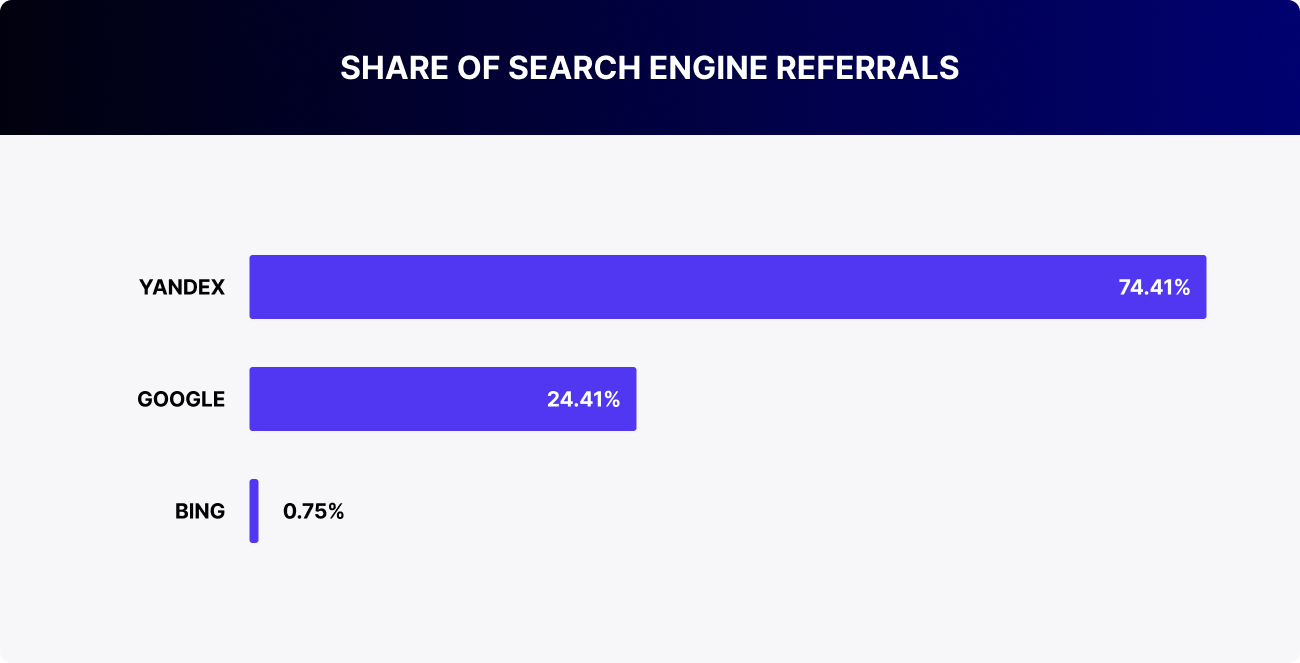
Paid ads on Yandex are not just a replacement for Google, but a full-fledged advertising ecosystem with dozens of formats, fine-tuned settings, and flexible strategies to meet any goal.
If you're planning to enter the Russian market, read on: this article provides a detailed guide on working with Yandex.Direct in 2025.
Yandex target audience: visitors and views in figures
As of 2025, Yandex reaches 101.9 million users in Russia each month — that’s 82.9% of the country’s population aged 12 and older. Every day, 72.1 million people open the platform, which amounts to 58.6% of the population. Yandex is the most visited online platform in Russia, known for its steady traffic and highly engaged user base. It has its own ad network (YAN), along with video and display formats that cover nearly the entire digital audience in the country.
The majority of Yandex users are based in Russia — 89.55%. Another 1.6% are in Belarus, 1.4% in Kazakhstan, and the rest are spread across other CIS countries and neighboring regions.
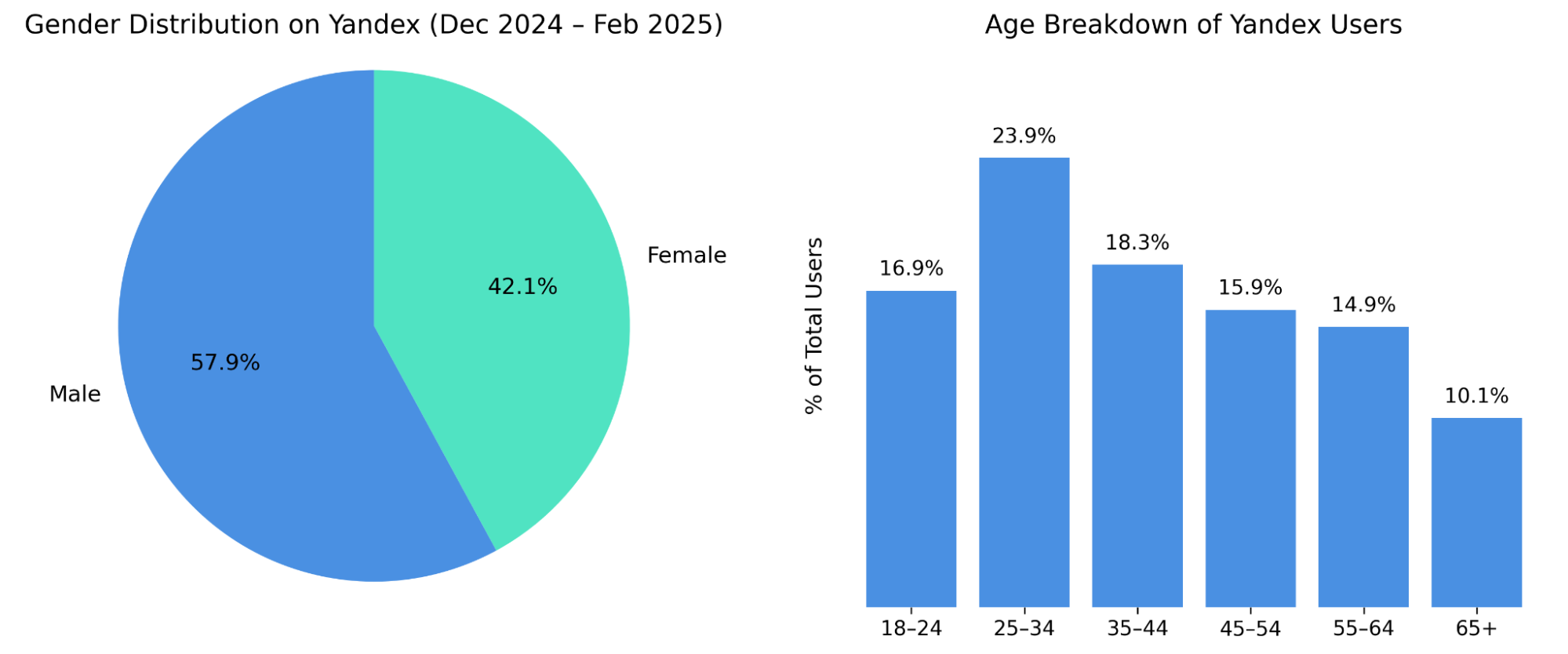
Demographic data shows that 57.9% of Yandex’s audience are men and 42.1% are women. The most active age group is 25–34, making up 23.95% of the user base. Users aged 35–44 account for 18.27%, while those between 18 and 24 represent 16.88%.
These segments form the core of a financially capable audience, making them especially valuable for performance marketing, from e-commerce to mobile apps and digital services.
How paid ads work in Yandex Search and its ad network
In 2025, paid ads on Yandex.Direct remain one of the most accurate ways to reach a targeted audience in Russia. The service automatically determines which ads to show users based on their queries, location, interests, and online behavior.
There are two main types: ads in Yandex search results (based on keywords) and on partner websites within the Yandex Advertising Network (YAN).
In the first case, the user is already searching for something, and the system displays a relevant ad right above or below the search results. This is a classic pull marketing approach, where the interest has already been established.
In the second case, the ad follows the user across other sites within the YAN, including news portals, forums, online stores, and video platforms. According to Yandex, YAN reaches over 65 million users daily, and about half of them don't overlap with the search audience.
Visually, the ads differ:
- In search results — a text and graphic block with a headline, description, links, phone number, and address (if provided);
- In YAN — banners (including video), dynamic ads, smart banners, and other visual formats.
For more details on technical requirements for ad formats, we have written about it earlier.
What to choose: search or YAN?
A common question from advertisers is whether to run ads in search or on the Yandex Advertising Network (YAN). The right approach in 2025 is not to choose between them, but to combine both. These are two different objectives and two different touchpoints with the user.
- Search — when the user is actively looking for a product or service. This is ‘hot demand’.
- YAN — when we build brand awareness, reignite interest, or show the product before or after the user has shown direct interest.
Therefore, the conclusion is clear — use both channels together to cover different stages of the funnel and amplify results.
Current ad formats in Yandex.Direct
Yandex.Direct offers both brand awareness and performance campaigns. For international brands entering the market, we recommend running both types.
Image advertising in Yandex.Direct and its formats
If the goal is to introduce a new product or expand brand reach among current and potential customers, brand awareness campaigns in Yandex.Direct are the way to go. These formats are designed to build recognition and create a strong association with a product or service in the audience's mind.
Regardless of the choice of image advertising format the budget of each of them will be calculated with the condition of payment for ad displays. The minimum budget is 300 rubles per week (approximately 43 rubles per day), excluding VAT.
Media banners in YAN
Display banners in YAN offer flexible settings for targeting based on user characteristics and keywords. This is a way to instantly reach tens of millions of users. The payment is made per 1,000 impressions (CPM), with targeting options such as geo, interests, and behavioral data (via Yandex.Metrica).
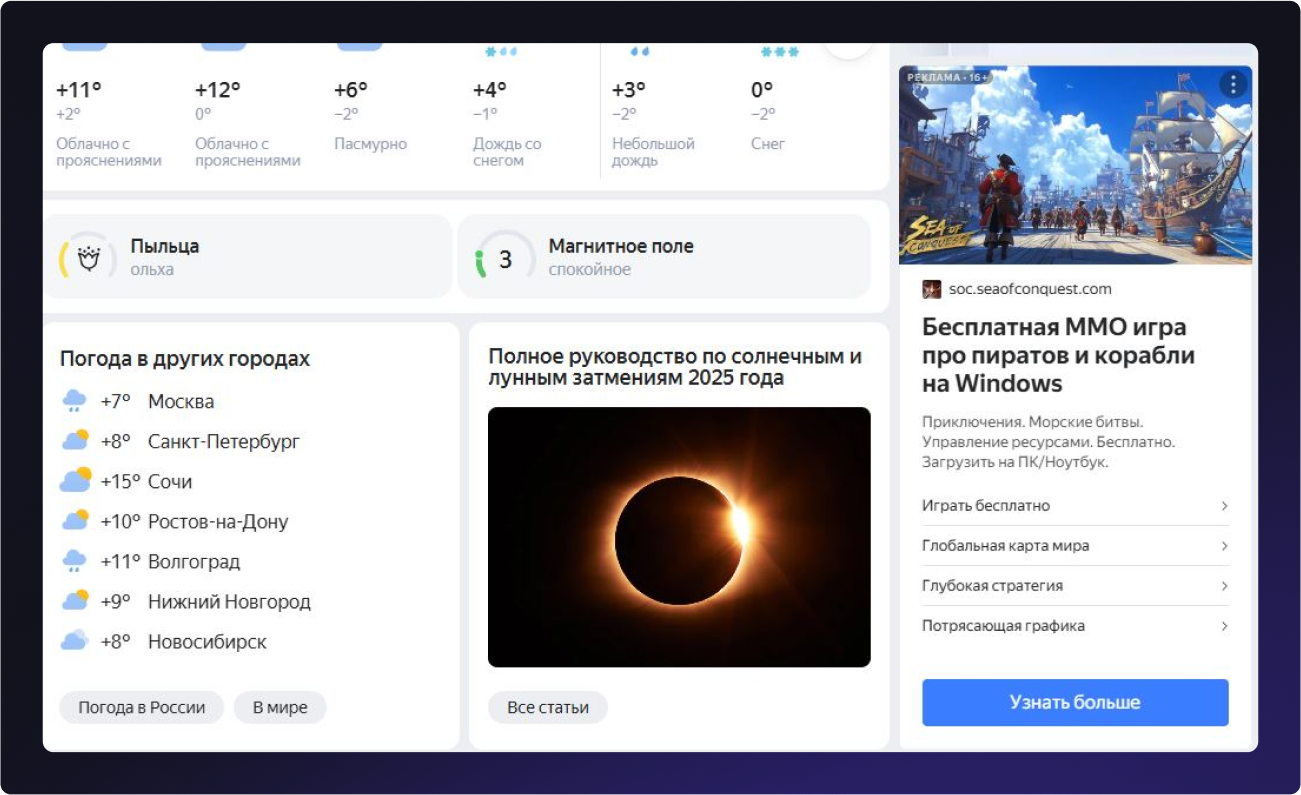
Example of media banner placement on the right side of the screen on Yandex.Weather service
When paying for 1000 impressions, an advertiser has an additional opportunity to place a premium billboard format in Yandex services (note - Yandex Video, Yandex Market, Yandex Pictures, Music, Movie Search, Teleprogram, Auto.ru, Edadil and others). The billboard is placed in the header of the service page and occupies the entire width of the screen. In addition to this format, advertisers can choose a single package of banner placement in the YAN, including Yandex partner sites (Afisha, Music, TV program, Real Estate, Maps, Auto.ru service). Depending on the site, the banner will be placed in different parts of the screen and slightly modified in size.
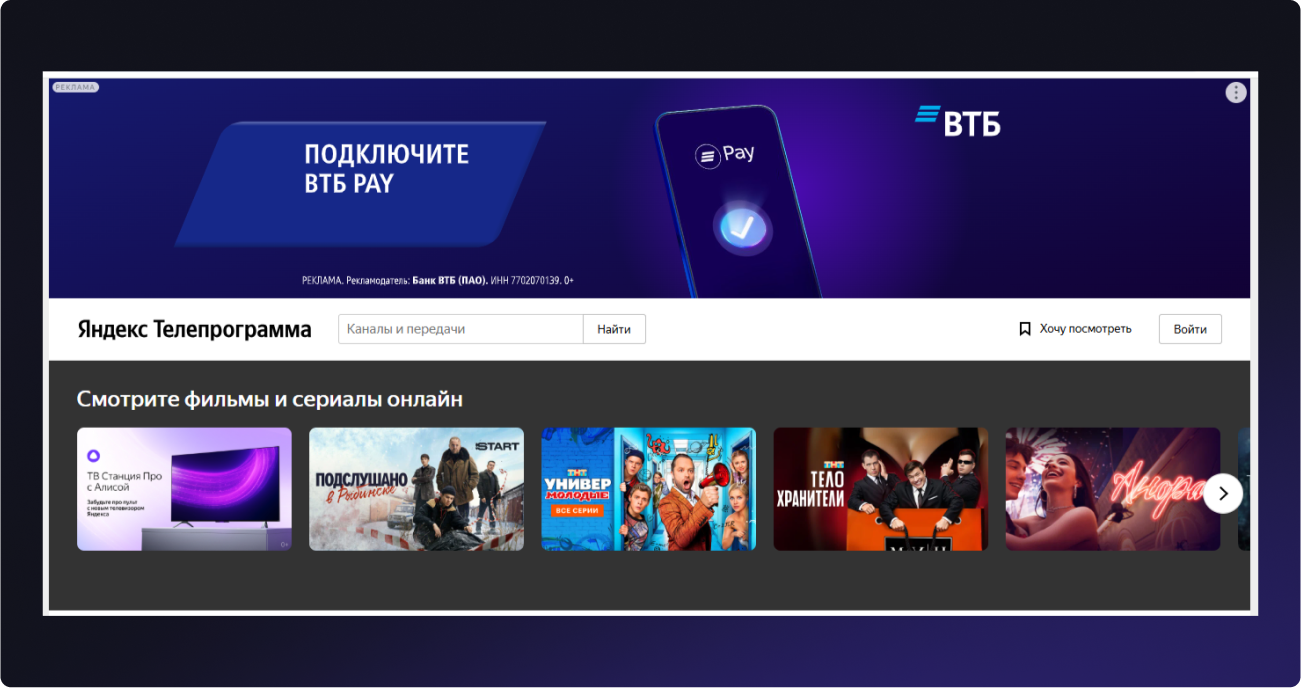
Example of premium billboard format
Display banners can also be placed in Yandex's search results, right under the search bar. This format increases reach and works on brand awareness from the very first seconds of contact. In the settings, you can adjust geo-targeting and the timing of ad display. After the campaign is launched, you can create a segment of users who saw the banner and continue engaging them through other paid ad formats that focus on actions — clicks, registrations, or purchases.
When paying per 1,000 impressions (CPM), display banners in Yandex search are available in two formats: premium banner and mini-banner. Both are placed on the right side of the screen and differ in size. Alternatively, you can run dynamic banners in YAN, which combine video and images.
This format effectively keeps the user's attention through movement and visual contrast. Banner creation is available directly within the interface, using Yandex.Direct’s creative builder.
Video ads in Yandex.Video Network
One of the most noticeable formats for brand promotion is video ads, which reach tens of millions of users on popular services and partner websites. Advertisers are drawn to this format for a simple reason: video content consistently remains the most popular in Russian internet usage. The overwhelming majority of the country’s audience watches video content every week. This is why video ads in Yandex.Video Network show high effectiveness. The format feels natural and appears where users are already accustomed to spending their time.
Placement options:
- InStream - streaming video that is broadcast at the beginning, middle or end of the main non-advertising video content;
- OutStream - a promotional video on the sites page;
- Interstitial - a promotional video in a mobile app before downloading or changing content;
- Rewarded - video ads in mobile game applications, for viewing which the user receives a reward (note - discount, game currency, etc.).
The campaign settings for audience characteristics will be identical to the settings for media banners in Yandex Advertising Network. However, the cost of video ads will depend on impressions or views. In the first case, the price is counted for viewing 2 and more seconds of the video, if at least 50% of the video player area is in the visible area of the screen. In the second case the price is counted if the video is less than 30 seconds and the user watched it to the end, or the user watched 30 seconds of the video and the video is longer, or the user went to the advertiser's site. If the viewer clicked the "Skip" button, neither the display nor the ad view is counted.
With a fixed payment for 1000 impressions in Yandex.Direct the advertiser has the option of placing an additional video format - multi-roll, which is played before/after the main Kinopoisk video player (note - the largest Russian-language service about movies and TV shows). The commercial can last 15 or 30 seconds, and can be posted in places where Kinopoisk is present on Yandex partner sites (note - Yandex.Afisha, Teleprogram, Video, etc.).

Example of multi-roll format placement in the Kinopoisk video player
In addition to the special video format, payment for 1000 impressions opens up the possibility of broadcasting audio ads between music tracks, podcasts on Yandex.Radio and Yandex.Music for users without subscription.
How to measure the effectiveness of a brand campaign? In brand awareness advertising, it’s not just about the number of impressions. Yandex.Direct allows you to measure how the ad has impacted audience behavior. This is called Brand Lift. For example, you can track the growth in brand-related searches after the campaign launch and the increase in direct visits to the website, as well as more repeat sessions from new users.
Such metrics show not just reach, but the effect of brand recall and interest. This is particularly important when entering a market or launching a new product, where the goal is not to make an immediate sale but to establish a presence in the user’s mind.
Additionally, you can set up brand lift research (Brand Lift Study) through Yandex or an external analytics system.How to measure the effectiveness of a brand campaign? In brand awareness advertising, it’s not just about the number of impressions. Yandex.Direct allows you to measure how the ad has impacted audience behavior. This is called Brand Lift. For example, you can track the growth in brand-related searches after the campaign launch and the increase in direct visits to the website, as well as more repeat sessions from new users.
Such metrics show not just reach, but the effect of brand recall and interest. This is particularly important when entering a market or launching a new product, where the goal is not to make an immediate sale but to establish a presence in the user’s mind.
Additionally, you can set up brand lift research (Brand Lift Study) through Yandex or an external analytics system.
Performance formats: how to generate leads and sales
The goal of performance advertising in Yandex.Direct is not just to show an ad, but to prompt the user to take a specific action: visit a website, place an order, register, or install an app. These formats target an audience that has already shown interest in a product or service, which helps increase conversion rates and lower the cost of acquisition.
When launching performance campaigns, the cost-per-click is determined through an auction model. The price is not fixed in advance and depends on the competition between advertisers for a specific audience, platform, and ad format. The system also allows for fixed budget parameters, such as a minimum amount to launch the campaign and a daily spend cap — 300 rubles excluding VAT.
Text and graphic ads (search and YAN)
Text and graphic ads are versatile and suitable for most industries, from services and e-commerce to B2B marketing. In 2025, these ads only work with automated strategies optimized for conversions.
The format supports feeds, quick links, sitelinks, and display URLs. Data can be directly uploaded from CRM systems or product catalogs, making it easier to scale campaigns and keep creatives up to date.
Ads can be placed both in search results (including in the product gallery) and within the Yandex Advertising Network, across mobile and desktop platforms. The main advantage of this format is its versatility. Advanced targeting settings allow you to reach different audience segments, and the ads are ideal for promoting a wide range of products and services. Additionally, creating a campaign takes minimal time: simply upload text, images, or videos, which can be edited at any time without restarting the campaign.
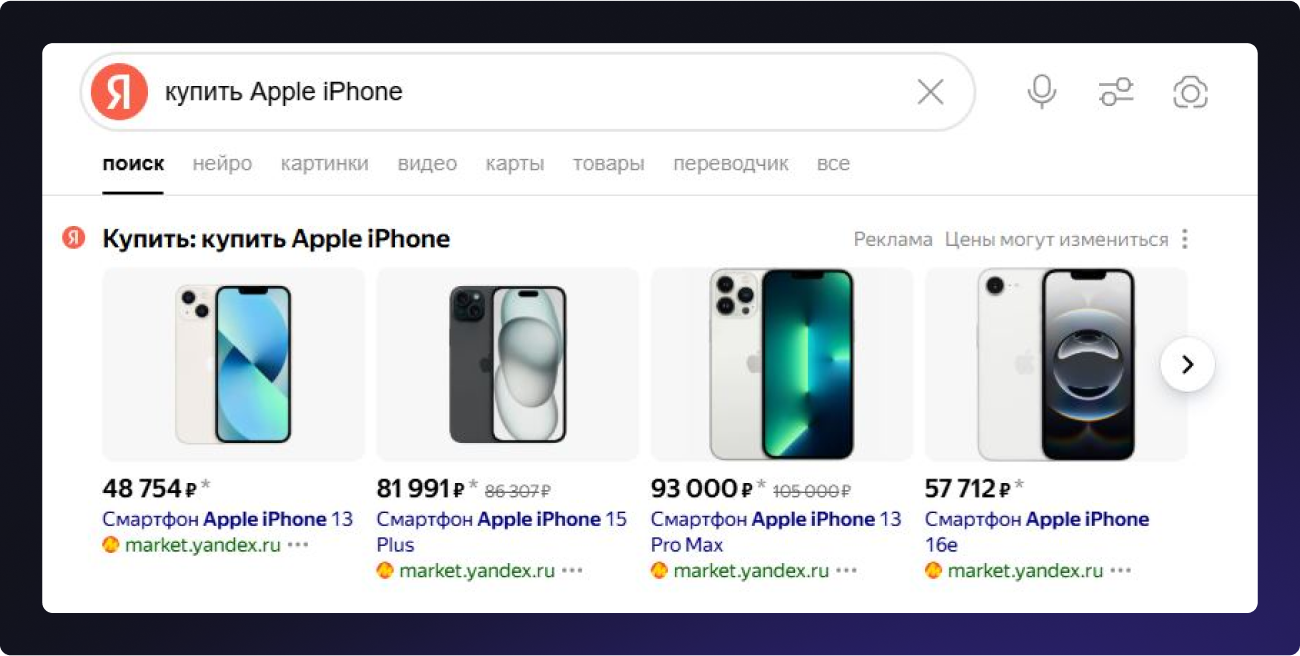
Example of text-graphic ads in the Yandex search engine in the product gallery
Graphic and smart banners
Due to the large image, graphic ads attract attention and help the user to quickly understand the essence of the advertisement. At the same time, the user gets to the advertiser's site by clicking on them. Here the majority principle starts to work: the more sites of the YAN distribute advertising, the more often it is selected for display to the audience. Therefore, a graphic banner can be created in several formats (note - graphics, animation, etc.) for different locations, which only increases the chances for success, that is, the target action of the user.

Example of a graphical advertisement in Yandex advertising network
As with image strategies, performance can have a separate banner on search, but with pay-per-click. It will be displayed to the right of the search results and will correspond to the user's search query. It’s important not to confuse this format with text and graphic ads: a search banner is a single visual block that appears once on the page and is designed for spotlight promotion of a specific product or service.
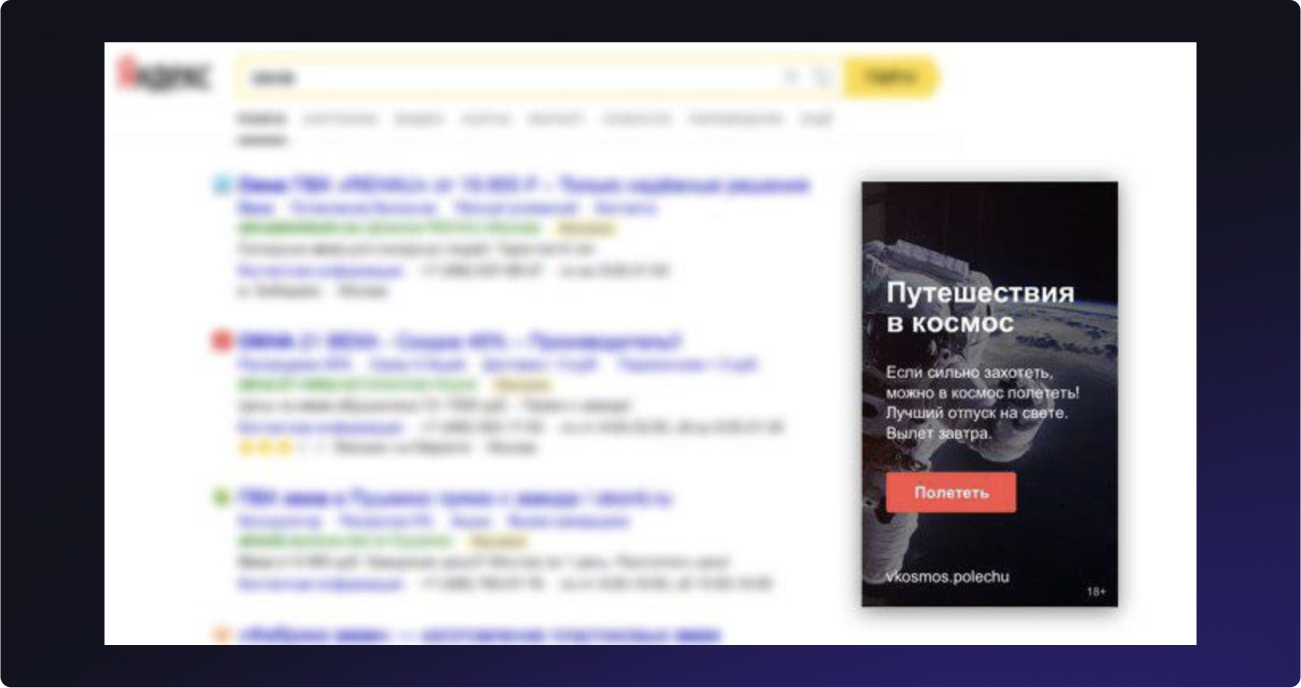
Example of placing a separate banner in the Yandex search results
Often, in the course of a campaign, advertisers have a need to show ads only to those users who have already been on the site or were interested in products similar to the object of advertising. For such a strategy Yandex.Direct uses smart banners in YAN. The process of creating ads is quite simple. The advertiser needs to specify the domain of the site or add a feed. Then, the Yandex system will analyze the content and automatically generate a series of smart banners (note - if there are many products) or a separate smart ad. Additionally, you can select the option to automatically download updates feed / site in the settings. Thanks to this, the information in the creative will always be up-to-date, if, for example, the price of goods has changed during the campaign.
These banners are ideal for e-commerce and multi-product brands. Yandex automatically generates ads based on product cards and user behavior. Retargeting is also used, so the ad follows the visitor across the Yandex Advertising Network (YAN).
Creating smart ads in Yandex.Direct begins with uploading a feed — a structured file containing data about products or services (name, price, link, image, availability, discount, etc.). The system then analyzes the content and automatically generates a smart banner, or multiple banners if the feed contains many items. The ads are shown in the YAN based on the user’s behavior and interests.
It’s worth highlighting the process of working with the feed. It can be uploaded manually as a file or through a direct link to an XML document hosted on the advertiser's website. In this case, the smart banners will be automatically linked to this feed via the URL, and the system will regularly update the data: prices, availability, descriptions. This approach is especially useful for online stores with large inventories or frequently changing catalogs.
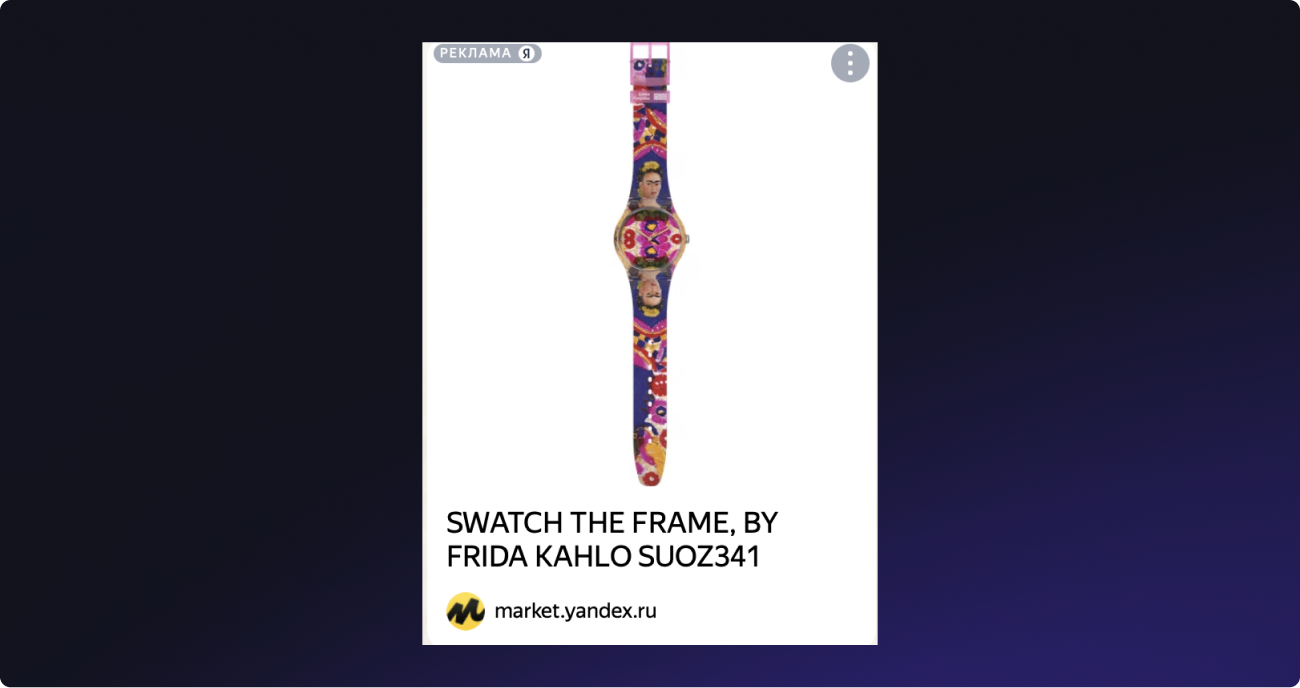
Mobile app promotion
The mobile app ad format in Yandex.Direct includes a Download button, supports the CPI model (cost per install), and offers placement in Yandex's mobile search, the Yandex Advertising Network (YAN), within Yandex apps and services, including Yandex.Music.
Available formats include video ads, graphics, interactive banners (such as mini-games), and text ads for mobile search results. The Download button leads the user directly to the app store, with no extra clicks or intermediate steps.
Within a single campaign, you can combine multiple formats, for example, running graphic banners in YAN alongside text ads in mobile search results.
In addition to the ‘install the app’ goal, the system allows you to optimize the campaign for further actions inside the app — such as registration, payment, and login — if the relevant tracking events are set up (e.g., through AppMetrica).
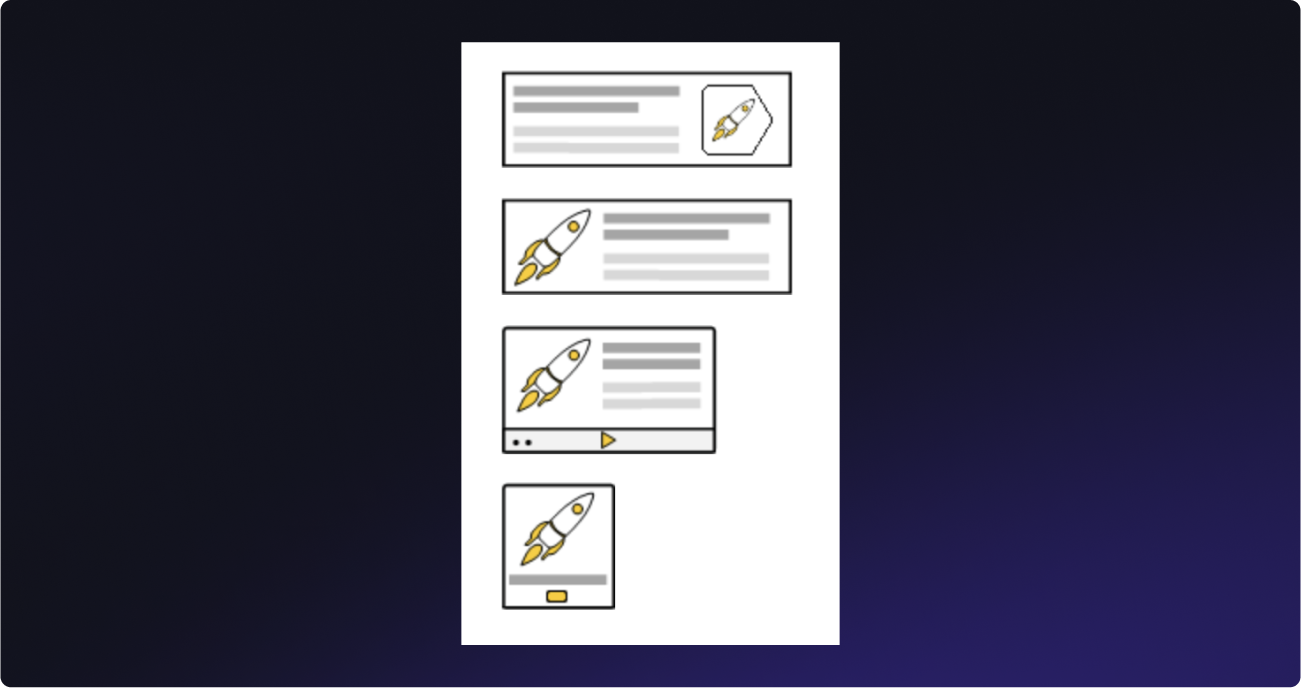
Product promotion on marketplaces
If you sell on platforms like Wildberries, Ozon, Yandex Market, or other major marketplaces, you can run ads in Yandex.Direct using a special scenario called Sales on Marketplaces. This template is built into the Campaign Builder and makes launching ads incredibly easy. The system automatically gathers ads from the product feed, configures links with tags, tracks effectiveness, and helps you get started quickly, even if you have hundreds of products in your catalog.
The main advantage is that the ads don’t just lead to a website but directly to the product page on the marketplace. This shortens the path to purchase and increases conversion rates.
A highly effective format considers the user's behavior and interests, for example, smart banners: the system pulls data from the product feed, analyzes the user's interests, and shows the most relevant products that are likely to catch their attention. The user doesn’t need to search for anything — the right product finds them.
In addition, ads can be shown on the Yandex Advertising Network. And if a user has already visited a product page but left without making a purchase, retargeting comes into play. The system reminds them of the viewed product, chasing them across other sites and bringing them back to complete the purchase.
Additionally, you can capture hot demand right when a user types in queries like "buy air humidifier Ozon" or "Nike Wildberries." Search ads work quickly: the ads appear in Yandex search results and immediately capture the attention of those who are ready to make a purchase.
This type of advertising is especially effective during sales and promotions, when you need to promote special offers and stand out among competitors quickly. It’s also essential at the launch phase to boost product pages, gather initial reviews, and improve rankings. And, of course, if the product has a high LTV (lifetime value), ads help attract customers who will return repeatedly.
Additional features:
- You can upload a separate feed with only the products you want to promote, such as those involved in a special offer.
- For Yandex Market, the system automatically adds links with parameters, so there’s no need to manually specify UTM tags.
- Auto-targeting is enabled by default: the system determines who to show the product to based on its description and demand.
- All campaigns are created quickly: there’s no need to write headlines or texts manually. Yandex automatically generates them from the feed data.
This approach saves time and makes promotion on marketplaces predictable and convenient, especially if you’re working with a large inventory.
Effective campaign launch strategies for 2025
As mentioned above, the main goal of performance in Yandex.Direct is the user's target action. This is the key principle of all campaign launch strategies, but they will differ from each other.
For example, the maximum conversions strategy is aimed at getting targeted visits to the site and increases the share of clicks on ads and key phrases that more often lead the user to the target action. Accordingly, payment for the campaign is calculated based on conversions that occurred within 21 days from the moment of the first click.
The Maximize Clicks strategy is designed to attract as much traffic as possible to your website within a set budget. The budget can be calculated based on the average cost per click or a fixed campaign amount. It's important to note that the cost per click can vary depending on the niche and competition. The minimum budget to launch this strategy is 300 rubles per day, excluding VAT.
For brands that want to make a statement without spending too much on clicks, the Maximum Impressions at the Lowest Price strategy is ideal. It applies to display formats in Yandex.Direct, where payment is based on 1,000 impressions (CPM) rather than clicks. The goal is to achieve the maximum audience reach within the given CPM bid.
In this case, Yandex's algorithm aims to show ads in slots where the CPM cost is the lowest while still ensuring the ad reaches the target audience. The system automatically determines the optimal locations and times for display to stretch the reach while maintaining effectiveness.
For a brand that is re-entering the market, especially in B2C sectors (fashion, cosmetics, electronics, food), or wants to increase brand awareness before launching, or to become a search reference point instead of being lost among general queries, the Brand Query Growth strategy is a good choice.
This strategy focuses not on immediate conversions but on generating branded demand: getting users to search for the brand by name in the future. For example, a user sees the banner ‘NEW Korean cosmetics K-Glow in the Russian market’, and the next day they type "K-Glow cream buy" into Yandex.
How it works: Yandex shows display ads to users who are most likely to be interested in the brand and will search for it in the future. After a series of impressions, the system tracks how the frequency of branded searches changes and adjusts the reach accordingly.
Branded traffic is the cheapest, most conversion-friendly, and stable. This strategy focuses on long-term capitalization of brand awareness, especially in highly competitive markets.
In some cases, Yandex.Direct may not receive enough conversions for effective learning, making it difficult to further optimize campaigns from the advertiser’s side. For such situations, Yandex.Direct has a batch strategy that combines several advertising campaigns of the same type with a single set of promotion indicators. Conversions obtained within the framework of such a strategy are used to train the system immediately for all combined campaigns. And when a new promotion is added, it will reach the specified optimization metrics faster. Up to 100 campaigns can be added to a single batch strategy at the same time.
The click optimization strategy for a search banner will be effective if the advertiser knows exactly how much they are willing to pay for a target action by a single visitor. This is a performance strategy based on CPC (cost per click). It allows you to get the maximum number of clicks per week, and the average cost per click (note: the ratio of weekly budget expenditure to weekly number of clicks) will not exceed the amount set by the advertiser.
The minimum average cost per click is 3 rubles, and this applies to the banner display strategy in search (CPM banner with click optimization). For standard search ads, the minimum CPC is much lower (0.3 rubles — the system’s minimum).
Previously, advertisers in Yandex.Direct could manually manage bids for each keyword or banner. However, by June 2024, the system fully transitioned to automated strategies for ad networks. The option for manual bidding was still available for search-only campaigns until the end of 2024, but Yandex recommended automated strategies. In 2025, it is no longer available. Yandex automatically calculates bids based on the selected goal: clicks, conversions, reach, or ROI now.
How retargeting in Yandex.Direct works
Retargeting (remarketing) in Yandex.Direct is a way to show ads to users who have already interacted with a brand. The system takes into account actions on the website: page views, adding products to the cart, visiting specific sections, or completing target actions.
This tool is not designed to attract new audiences. Its purpose is to bring back those who have already shown interest, increase conversion and reduce the cost per request (CPL/CPA).
Segments for retargeting are created using two tools:
- Yandex.Metrica allows you to set up goals, for example, page views, conversions, or time spent on the site.
- Yandex.Audiences is used for uploading customer data such as phone numbers, emails, and CRM databases. This tool also allows you to create look-alike and geo-segments.
Both tools integrate with Yandex.Direct. Once a segment is created, it becomes a condition for displaying ads.
In search results, retargeting is always used alongside keyword phrases or auto-targeting. For example, if a user searches "buy New Balance sneakers" but has previously visited the advertiser's website or added the product to their cart, the system prioritizes that ad, even in the face of high competition.
This method works in text and graphic ads, dynamic creatives (DCO), and mobile app promotion campaigns.
In the Yandex Advertising Network (YAN), retargeting is not dependent on keywords. To start, you simply set one or more conditions, such as viewing a product without purchasing. After that, the ad will be shown on partner websites: news portals, forums, Yandex services, and others.
One typical scenario: a user showed interest in a tour but didn't complete the booking. A few hours later, they visit Kinopoisk or Yandex.Weather and see a banner with the same tour or a similar offer.
Retargeting Setup:
- Goals are created in Yandex.Metrica, for example, ‘viewed product page’, ‘added to cart’, ‘spent more than 60 seconds on the site’.
- Customer lists are uploaded in Yandex.Audiences for both exclusions from displays and for remarketing purposes.
- In Yandex.Direct, you configure the display conditions and specify the desired segment.
Why is retargeting especially important now?
In 2025, retargeting remains one of the most effective tools for working with warm audiences. It helps reduce acquisition costs: users are already familiar with the brand, tend to trust it more, and are more likely to click on the ads.
Moreover, retargeting increases conversion rates — it allows you to bring back users who showed interest but didn't make a purchase the first time. These users have already made half the journey and often become more loyal when their attention is captured again.
An additional advantage is access to analytics. With Yandex.Metrica, you can understand how exactly retargeting impacts user behavior and sales. Based on this data, campaigns can be adjusted for specific segments, making the advertising more precise and investments more justified.
Below is a complete funnel of audience interaction in Yandex.Direct, from the first contact with the brand to bringing them back.
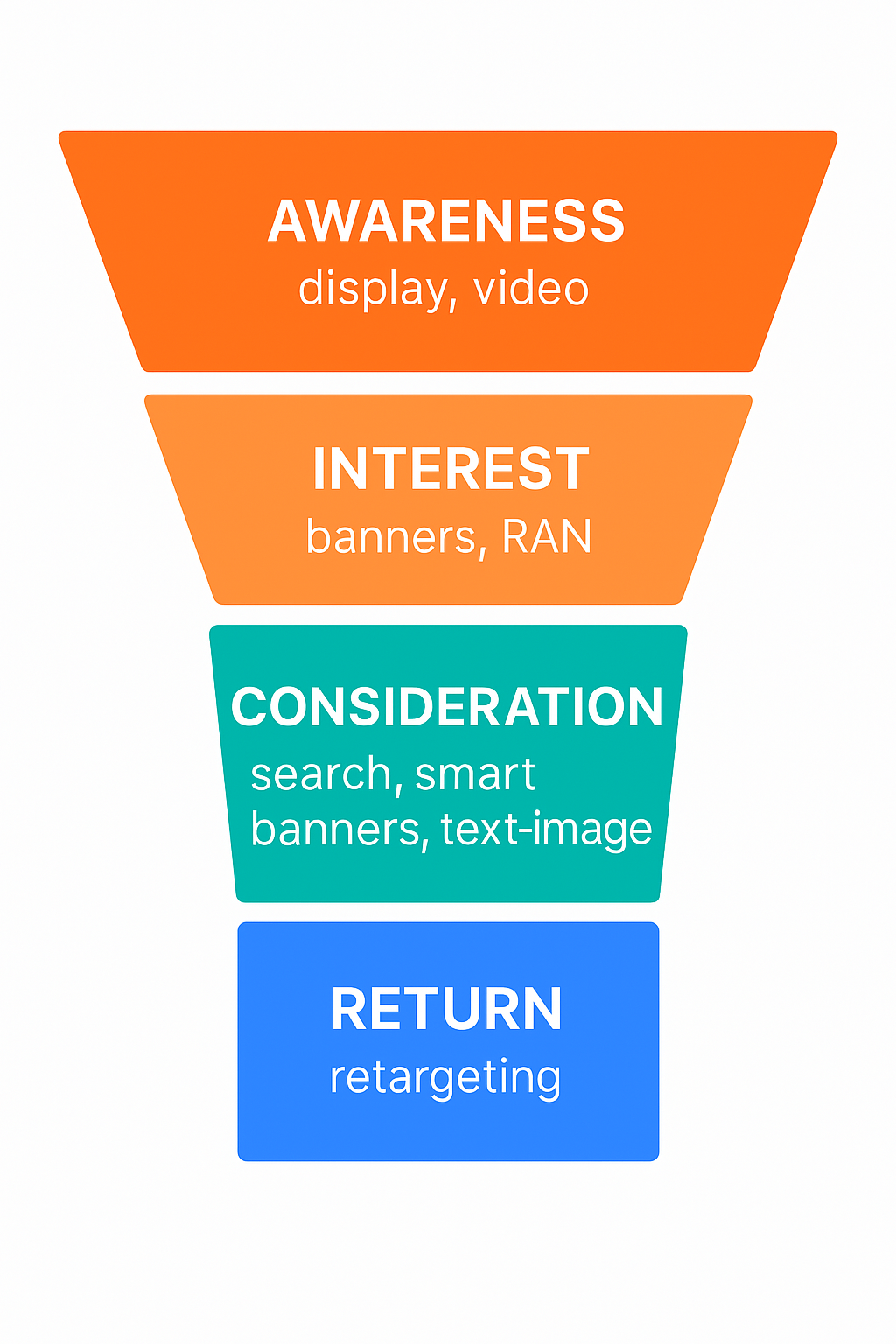
Retargeting works at the final stage when a person has already seen an ad, visited the site, but didn't make a purchase. At this point, they are chased with a personalized ad and brought back to complete the purchase.
It is important to understand that different Yandex.Direct formats are used at different stages: display and video ads for reach, search and smart banners for action, and retargeting to avoid losing warm visitors.
In addition to Yandex.Direct, another advertising system operates in Russia — VK Ads. This system is used for placing ads within the social networks VKontakte, Odnoklassniki, and Rutube, as well as within the MyTarget network. More details about it can be found here. Below is a brief comparison of the capabilities of VK Ads and Yandex.Direct for brands entering the Russian market.
Comparison with VK Ads: what to choose?
When a foreign brand enters the Russian market, a natural question arises: if Yandex.Direct is considered the main tool for context-based advertising, what role does VK Ads play? Both services are in demand, but they work differently, and their effectiveness depends on the goals of the advertising campaign.
The first difference is in reach and audience type. Yandex.Direct covers up to 102 million internet users per month: this includes not only search ads but also ads in the Yandex Advertising Network, Yandex services, and on tens of thousands of partner sites.
VK Ads operates within its ecosystem: the social networks VKontakte, Odnoklassniki, the video hosting service Rutube, and the MyTarget ad network. The combined reach is about 93 million people. A significant portion of this audience overlaps with Yandex, but search traffic is not included here. Ads are shown to people who aren’t actively searching at the moment but are simply consuming content.
This leads to a key difference in purpose and campaign types. Yandex.Direct is focused on performance objectives: lead generation, order acquisition, optimization for applications, sales, and ROI. It is perfect for capturing hot demand: the user actively types a query like "buy a laptop," and the system shows a relevant ad. Retargeting support via Yandex.Metrica and Audiences helps bring back those who have already shown interest.
VK Ads works differently. It’s an environment for brand promotion through engagement and reach. The platform is effective in campaigns where the goal is not necessarily to sell, but to make a lasting impression: telling the brand’s story through video, engaging posts, contests, articles, or user-generated content (UGC). It works particularly well in FMCG, lifestyle, entertainment segments, and personal branding. Built-in lead collection forms (VK Lead Ads) allow you to gather contact information directly within the social network without redirecting users to the website. This is convenient for simple offers or quick promotions.
User behavior on these platforms is also different. On Yandex, people act with intent — they are searching for a product or service and are ready to take the next step. This is a warm audience, and it’s easier to work with them in the funnel. On social media, users are more likely to be scrolling through their feed, watching videos, or chatting. To get them to take a target action, you first need to capture and hold their attention. This requires a creative approach, and the result can be less predictable.
These differences are also reflected in the available formats and analytics tools. Below is a brief comparison of Yandex.Direct and VK Ads capabilities:
| Parameter | Yandex.Direct | VK Ads |
|---|---|---|
| Search | Available | Not available |
| Site Retargeting | Metrica, Audiences | Pixel (limited)* |
| Video | Video Network, Kinopoisk | VK Video, Stories |
| Smart Bidding | Conversion optimization | Partially, less flexible |
| Built-in Lead Forms | No (redirects to site) | Yes (VK Lead Ads) |
| Automation & API | Advanced functionality | Available, but less flexible |
**VK Pixel allows you to collect a website visitor audience and target them, but the depth of analysis is limited (there are no similar metrics to Yandex.Metrica).
When comparing analytics capabilities and formats, Yandex.Direct has more tools for optimization based on business metrics: it includes smart strategies, advanced integration with Yandex.Metrica, retargeting, API, and detailed traffic source statistics. VK Ads lags behind in flexibility but offers built-in lead collection forms and seamlessly integrates ads into the news feed.
In the end, the choice depends on your goals. When sales, app installs, leads, and direct traffic to the website are a priority, Yandex.Direct is more reliable. If the task is to create an emotional connection to the brand, increase awareness, and build a community, VK Ads complements the reach part of the strategy very well.
In practice, a combination is often used: Yandex solves performance marketing tasks, while VK helps with engagement and brand building. Distinguishing the roles of these channels allows you to get the most out of each.
Let’s summarize
Yandex.Direct holds a central position in paid advertising in Russia, integrating search, display and video formats, retargeting, and mobile app promotion. It is an ecosystem that covers all stages of the funnel, from awareness to purchase.
The effectiveness of campaigns depends not on the number of features, but on understanding the goals, the audience, and the platform's logic. Last year, the system fully transitioned to automated strategies — manual bid management no longer works. Therefore, it is essential to test hypotheses, track real results, and adjust campaigns based on data.
Audience structure requires attention: overlapping segments lead to internal competition and increased costs. It’s better to merge these segments and assess them together. Creatives should also not be universal — different segments and goals require different ads and landing pages.
The choice of formats should align with the task at hand. For direct sales, search and smart banners are effective; for brand awareness, video and display ads work well; and for remarketing, retargeting is essential. However, all of this only makes sense when supported by analytics: without data from Yandex.Metrica and CRM, the budget is simply being wasted.
If you plan to use Yandex.Direct as a full-fledged growth tool, make sure the campaign is managed by a specialist who can work with the numbers, not just the interface.
If you need support, RMAA can help launch the system from scratch: from strategy and creatives to analytics and scaling. Retargeting, segmentation, A/B testing, transparent reports — you'll understand how your budget is working and why.
Leave a request, and we'll build a working digital marketing structure in Russia tailored to your brand. To stay updated on trends and practices, subscribe to our blog.
Join 2,000+
of your Peers!
You will be the first to know about Russian marketing insights, news and updates from our agency. Stay tuned!
Get our latest articles delivered to your email inbox and get our exclusive White Paper
"Digital Marketing in Russia. Finding your customers on the internet"
for FREE!
Russian Digital Market Overview
Strategic Insights into Russian Digital Marketing Landscape
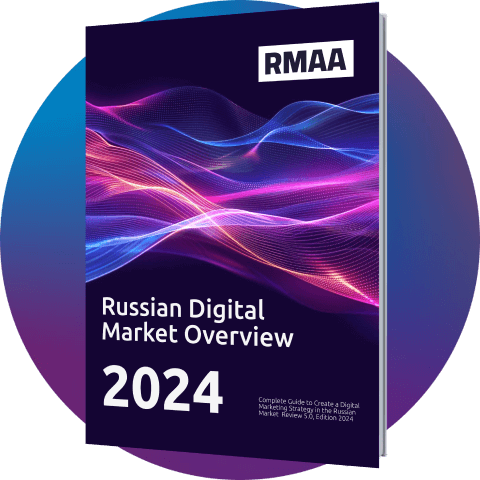
Ready to partner with the specialists in Russian marketing and advertising?
About the Author
A content lead. Natalia runs marketing projects promotion with different digital tools in the Russian-speaking market.
Join 2,000+ of your Peers!
Get our latest articles delivered to your email inbox and get our exclusive White Paper "Digital Marketing in Russia. Finding your customers on the internet" for FREE!
You will be the first to know about Russian marketing insights,
news and updates from our agency.
Stay tuned!
We're updating our website's design step by step, so some pages may look different. Thank you for your understanding.
Got it








